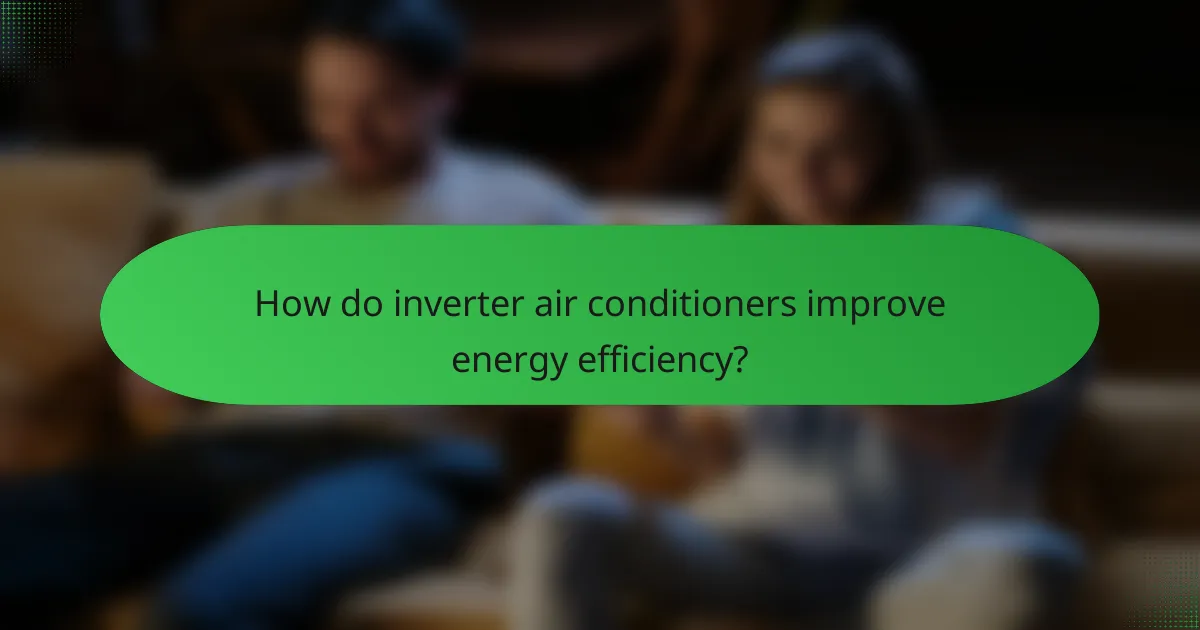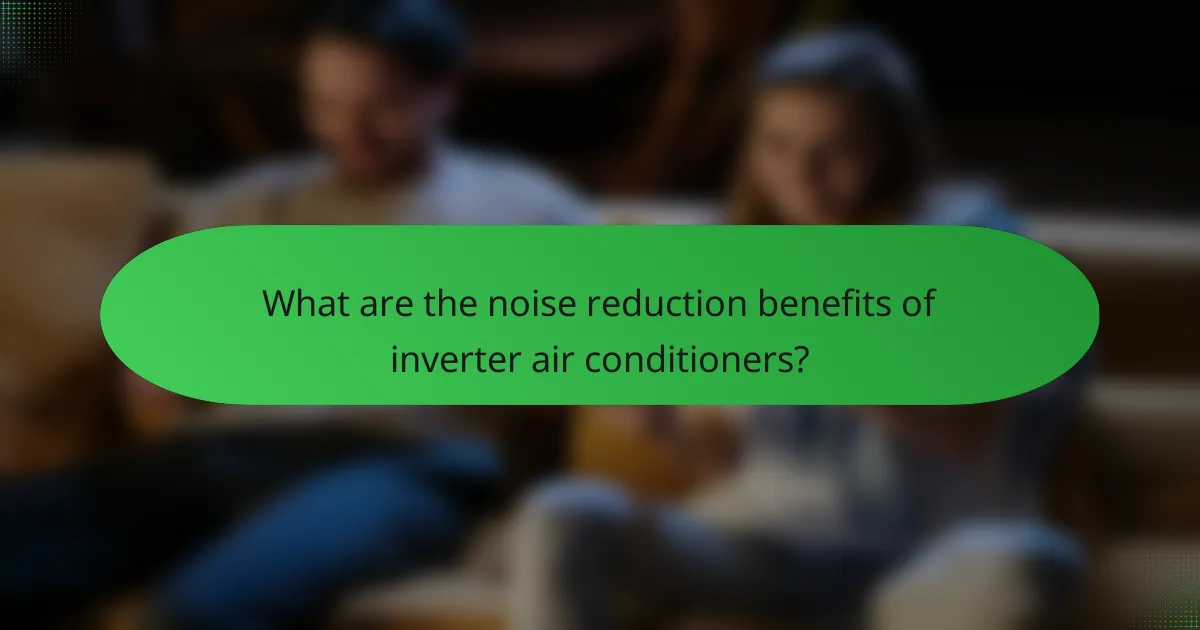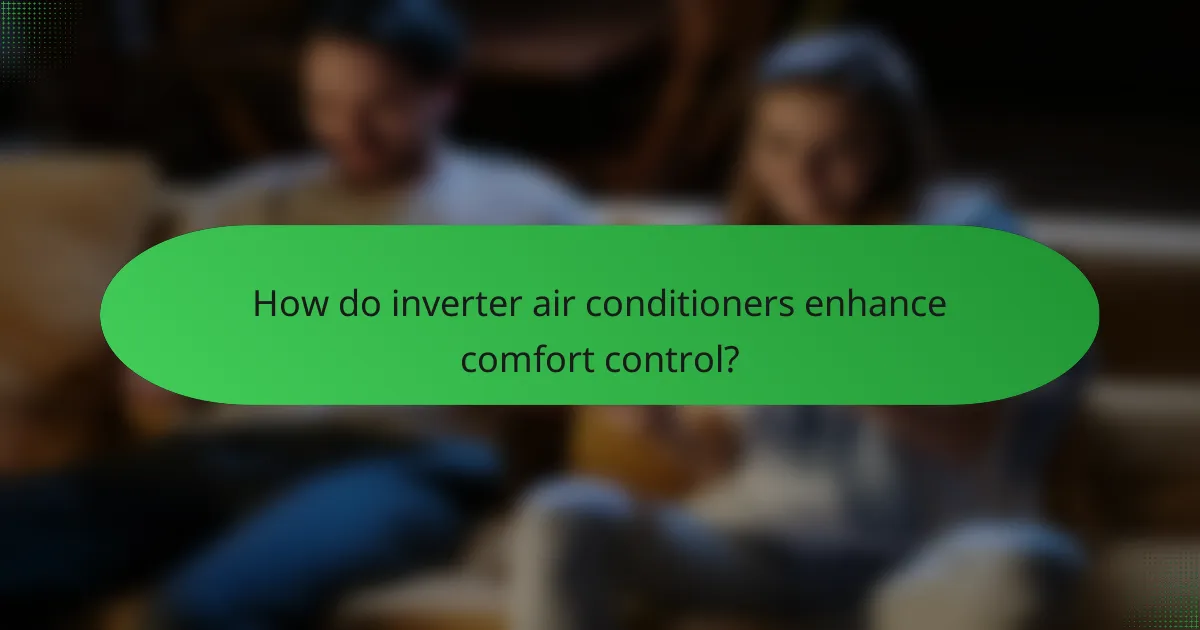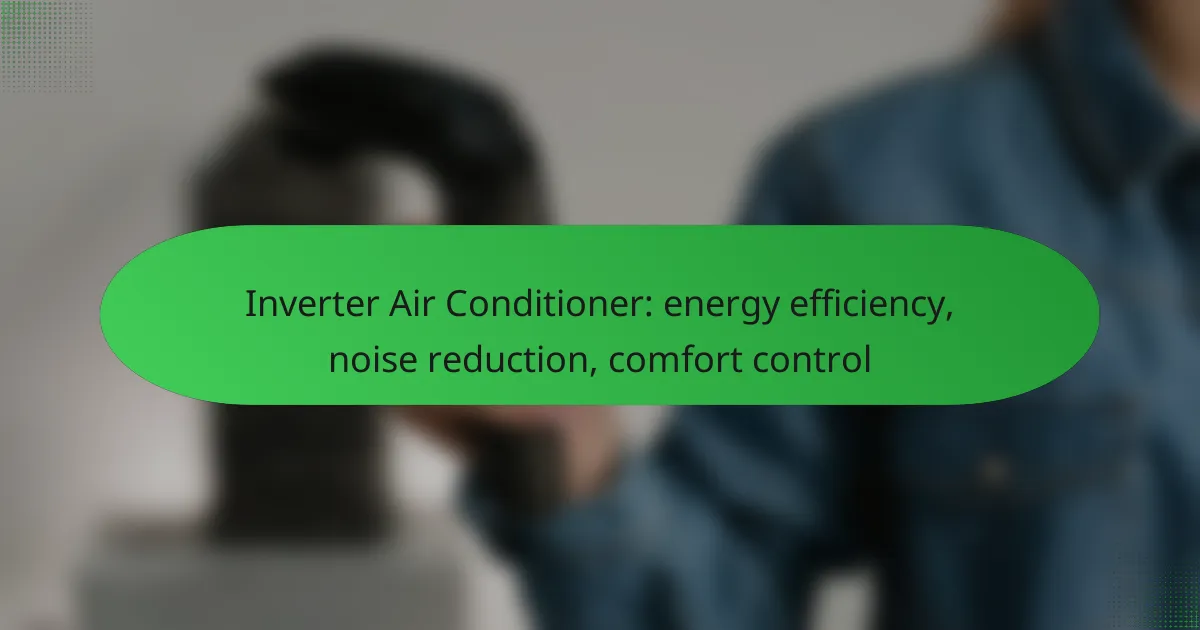Inverter air conditioners are designed to optimize energy efficiency by adjusting compressor speeds in response to cooling demands, which helps lower energy consumption and utility bills. They also provide significant noise reduction, operating more quietly than traditional units, ensuring a peaceful indoor environment. Additionally, these systems enhance comfort control by maintaining a consistent indoor climate, reducing temperature fluctuations for improved overall comfort.

How do inverter air conditioners improve energy efficiency?
Inverter air conditioners enhance energy efficiency by adjusting their compressor speed to match the cooling demand, rather than turning on and off like traditional units. This technology leads to reduced energy consumption and lower utility bills.
Variable speed compressor technology
Variable speed compressor technology allows inverter air conditioners to operate at different speeds based on the current temperature and cooling needs. This means the system can run at a lower speed for longer periods, maintaining a consistent temperature without the energy spikes associated with frequent on-and-off cycles.
By modulating the compressor speed, these units can achieve more precise temperature control, leading to improved comfort levels in the home. This adaptability not only enhances comfort but also minimizes energy waste.
Energy Star certification
Energy Star certification indicates that an inverter air conditioner meets strict energy efficiency guidelines set by the U.S. Environmental Protection Agency. Certified units typically use 10-50% less energy than standard models, making them a smart choice for eco-conscious consumers.
When shopping for an air conditioner, look for the Energy Star label, as it signifies that the unit has been tested for efficiency and can help reduce your carbon footprint while saving on energy costs.
Reduced energy consumption
Inverter air conditioners can significantly lower energy consumption compared to traditional units. By continuously adjusting the compressor speed, they operate more efficiently, especially during partial load conditions when cooling demands are lower.
For example, during mild weather, an inverter unit can run at a lower capacity, consuming less energy while still providing adequate cooling. This results in a more sustainable approach to air conditioning, particularly in regions with varying climates.
Cost savings over time
While inverter air conditioners may have a higher upfront cost, they often lead to substantial cost savings over time due to their energy-efficient operation. Homeowners can expect lower monthly energy bills, which can offset the initial investment within a few years.
Additionally, many utility companies offer rebates or incentives for purchasing Energy Star-certified units, further enhancing the financial benefits. Over the lifespan of the unit, these savings can amount to hundreds of dollars, making inverter air conditioners a wise long-term choice.

What are the noise reduction benefits of inverter air conditioners?
Inverter air conditioners offer significant noise reduction benefits compared to traditional units, primarily due to their variable-speed compressors. These systems operate more quietly, providing a comfortable indoor environment without disruptive sounds.
Quieter operation compared to traditional units
Inverter air conditioners typically operate at lower decibel levels than conventional models, which can be quite loud during operation. While traditional units may reach noise levels of 60-70 dB, inverter models often operate between 30-50 dB, making them suitable for bedrooms and quiet spaces.
This quieter operation is achieved through a more efficient compressor design that adjusts its speed based on the cooling demand, reducing the frequency of loud on-off cycles common in traditional systems.
Sound-dampening technology
Many inverter air conditioners incorporate sound-dampening technology, such as insulated compressor compartments and vibration-reducing mounts. These features minimize noise transmission and vibrations, further enhancing the overall quietness of the unit.
Additionally, some models include advanced fan designs that reduce airflow noise, making them ideal for environments where noise is a concern, such as offices or homes with open floor plans.
Decibel levels of popular models
When evaluating inverter air conditioners, it’s helpful to compare the decibel levels of popular models. For example, many well-known brands offer units that operate at around 30-40 dB on low settings, while others may reach up to 50 dB at maximum capacity.
Here’s a quick comparison of a few popular inverter models:
| Model | Noise Level (dB) |
|---|---|
| Brand A Model 1 | 32 |
| Brand B Model 2 | 40 |
| Brand C Model 3 | 48 |
Choosing a model with lower decibel levels can significantly enhance your comfort, especially in noise-sensitive areas of your home or workplace.

How do inverter air conditioners enhance comfort control?
Inverter air conditioners improve comfort control by adjusting their cooling and heating output based on real-time temperature needs. This technology allows for a more consistent indoor climate, reducing temperature fluctuations and enhancing overall comfort.
Precise temperature regulation
Inverter air conditioners use advanced sensors to monitor indoor temperatures continuously. This enables them to adjust the compressor speed dynamically, maintaining a stable temperature within a narrow range, typically around 1-2 degrees Celsius. As a result, you experience fewer hot or cold spots in your living space.
Unlike traditional units that turn on and off, inverter systems operate more smoothly, which contributes to a more comfortable atmosphere. This precise control can lead to energy savings, as the system avoids the energy spikes associated with frequent on-off cycling.
Faster cooling and heating response
Inverter air conditioners can reach desired temperatures more quickly than conventional models. By varying the compressor speed, they can deliver higher cooling or heating output when needed, reducing the time it takes to adjust the indoor climate. This rapid response can be particularly beneficial during extreme weather conditions.
For instance, if you set your air conditioner to cool a room from 30°C to 22°C, an inverter unit may achieve this in a matter of minutes, while a non-inverter model could take significantly longer. This efficiency not only enhances comfort but also minimizes energy consumption during peak demand periods.
Smart thermostat compatibility
Many inverter air conditioners are compatible with smart thermostats, allowing for greater control over your indoor environment. These systems can be programmed to adjust temperatures based on your schedule or preferences, further enhancing comfort and energy efficiency.
Smart thermostats can learn your habits and optimize settings accordingly, ensuring that your home remains comfortable when you’re there and saves energy when you’re away. This integration can lead to additional savings on your energy bills, making it a practical choice for modern households.

What factors should be considered when selecting an inverter air conditioner?
When choosing an inverter air conditioner, consider room size, cooling capacity, installation requirements, and brand reputation. These factors significantly influence energy efficiency, noise reduction, and overall comfort control.
Room size and cooling capacity
Room size directly impacts the cooling capacity needed for effective temperature control. An air conditioner’s capacity is typically measured in BTUs (British Thermal Units), with common ranges for residential units being from 5,000 to 24,000 BTUs. For optimal performance, match the unit’s capacity to the room size; for example, a 150-250 square foot room usually requires around 6,000-8,000 BTUs.
Under-sizing can lead to insufficient cooling, while over-sizing may result in frequent cycling, reducing energy efficiency. Always refer to manufacturer guidelines for specific recommendations based on room dimensions.
Installation requirements
Proper installation is crucial for maximizing the efficiency and performance of an inverter air conditioner. Ensure that the unit is installed in a location that allows for adequate airflow and is not obstructed by furniture or other objects. Additionally, consider the type of installation required, such as wall-mounted, window, or portable units.
Check local building codes and regulations, as some areas may have specific requirements for installation. Hiring a professional installer can help avoid common pitfalls and ensure the unit operates effectively from the start.
Brand reputation and reviews
Brand reputation plays a significant role in the reliability and longevity of an inverter air conditioner. Research brands known for their quality and customer service, and look for models with positive reviews from users. Websites and forums can provide insights into real-world performance and satisfaction.
Consider brands that offer warranties and support, as these can indicate a commitment to quality. Reading reviews can help identify common issues and advantages, allowing for a more informed purchasing decision.

What are the top inverter air conditioner brands in the UK?
The leading inverter air conditioner brands in the UK include Daikin, Mitsubishi Electric, and LG. These brands are recognized for their energy efficiency, noise reduction, and advanced comfort control features, making them popular choices among consumers.
Daikin
Daikin is renowned for its innovative technology and energy-efficient inverter air conditioners. Their units often feature advanced inverter compressors that adjust power output based on the cooling or heating demand, resulting in lower energy consumption and reduced utility bills.
When considering Daikin models, look for features such as the “Intelligent Eye” sensor, which detects human presence and adjusts operation accordingly. This can enhance comfort while minimizing energy waste.
Daikin air conditioners typically come with a range of SEER (Seasonal Energy Efficiency Ratio) ratings, often exceeding industry standards, which can lead to significant savings over time. Be sure to evaluate the specific model’s efficiency rating to ensure optimal performance.
